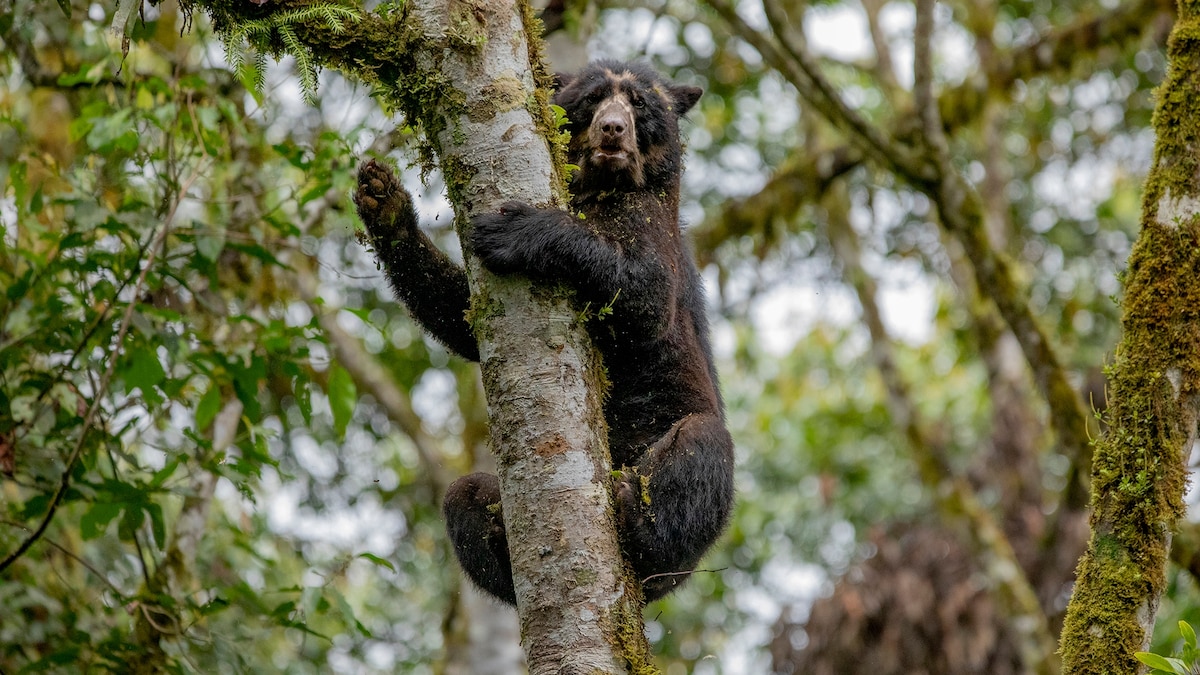Now Reading: We thought Andean bears were mute. Then scientists heard them mating.
-
01
We thought Andean bears were mute. Then scientists heard them mating.
We thought Andean bears were mute. Then scientists heard them mating.

Until recently, the Andean bear—the only species of bear in South America, easily recognized by the light-colored markings that frame its face like glasses—was thought to be almost mute; there were only a few documented cases of vocal exchanges between mothers and cubs in captivity. But recently, deep in the Andes, camera traps captured something unexpected: During mating, this elusive creature becomes surprisingly expressive. It moans, growls, and purrs.
With this new information, scientists are finally starting to decipher its language.
(This biologist and her rescue dog help protect bears in the Andes.)
The Andean bear’s language of love
This discovery was part of a study published in the Mexican Journal of Biodiversity in January. Between 2020 and 2021, a team of researchers hid camera traps in the forests of the Colombian and Bolivian Andes in hopes of spotting the mysterious Andean bear.
The resulting recordings captured an array of sounds from the bears—grunts, gasps, and rhythmic hums—that contradicted everything previously known about this species. Far from silent, the bears were actually vocalizing with a rich and varied repertoire—and not just occasionally, but during one of their most private moments.
“The literature said these animals were silent,” says Ángela Mendoza-Henao, a research associate at the Sound Collection of the Alexander von Humboldt Institute for Biological Resources Research and one of the authors of the study. “But we could see they were constantly making many sounds…for hours.”
The study reveals the bear’s unique vocal repertoire, composed of five distinct sounds, each with a clear purpose. The bite—a sharp, brief squeal reminiscent of the creak of a rusty hinge—is exclusive to females during contact with the male. “It’s the aural response to the male’s bite on the neck during mating,” explains Nicolás Reyes-Amaya, curator of the Humboldt Institute’s Mammal Collection and another author of the study. “The male becomes a little more excited, and the two enter a more intense phase.”
This is the first time that sounds of this kind have been documented in any bear species. In the case of the Andean bear, traditionally considered extremely silent, the discovery is even more revealing. What we are hearing is, at the very least, the beginning of a bear’s climax.
(Ruthmery Pillco Huarcaya: Protecting the legend of her youth, the Andean bear.)
Using concrete data to analyze bear sounds
The bite sound was identified thanks to the acute hearing of Adriana Reyes, one of the lead authors of the study, who recently passed away. She processed countless hours of recordings captured by the cameras into spectrograms. The paper describes the bite as a variant of the humm, the most common sound between males and females that resembles a feline-like purr.
In front of the camera traps, each copulation lasts at least an hour. “They are making sounds all the time,” Mendoza-Henao points out. “They are not spontaneous vocalizations.”
You May Also Like
Yet none of these vocalizations have ever been observed in the presence of humans. While this particular study did not assess how the bears behave around people, Reyes-Amaya notes that many mammals reduce their vocal activity when humans are nearby, likely to avoid detection. “It wouldn’t be unusual for this to be the case with the bear,” he says, “but we would need to test it.”
Until now, most acoustic recordings of bears were vague descriptions, based on onomatopoeia or the intuition of the human ear, so they remained anecdotal. This study, on the other hand, analyzes the Andean bear’s sexual repertoire for the first time using field-measured data, clearing away the onomatopoeia and giving a scientific voice to the pants, grunts, and snorts.

Not only are Andean bears quiet around humans, but they also have a tendency to hide well in treetops.
Photograph by Thomas Peschak, Nat Geo Image Collection
Studying bears in other regions
Sexual activity between the bears was recorded in all three locations over three months. Not only was this the first time the Andean bear’s romantic and sexual voice was heard, but it was also the first time it was seen mating in the wild. “It was a matter of luck,” says Reyes-Amaya.
Although the Andean bear can measure up to 6.56 feet in length, “they can be very cryptic when they want to be,” Reyes-Amaya notes. The bear knows how to hide very well in the treetops, for reasons scientists still don’t understand, so it’s rare for humans to spot their imposing silhouette—one of the largest among tropical forest mammals. What is more common is to stumble upon the markings they leave on the bark of trees or the vegetation they tread.
(Bears seen mating in trees—a scientific first.)
Even so, the Andean bear travels several miles per day. That’s why Mendoza-Henao believes it’s key to have sound recordings from different regions to study the possible existence of dialects between distant populations. Andean bears live along the spine of South America, from Venezuela to Bolivia, and have adapted to cold environments such as high Andean forests and high-altitude tropical grasslands found above treelines.
“Do bears in Ecuador speak differently from those in Colombia? Do they have a different accent from bears in Bolivia? We don’t know yet,” says Reyes-Amaya.
This discovery also opens the door to analyzing how other bear species communicate. Not all bears vocalize the same way; polar bears, for example, make almost no sounds, except for some snorts during confrontations between males or exchanges between mothers and cubs. On the other hand, black bears are typically louder than brown bears, perhaps because they live in dense forests where it’s difficult to see, so their voices become a key tool to communicate with each other. Even pandas, which emit at least 11 distinct sounds in the wild, become especially noisy when they are in heat in captivity.
For Reyes-Amaya, these kinds of findings transcend the anecdotal. “This study is wonderful in itself, because it helps us understand and learn a little more about a majestic being,” he says.
The Andean bear’s vocal repertoire not only expands what we know about its species, but also reveals how, in their world, they make themselves heard when no one is looking.
























